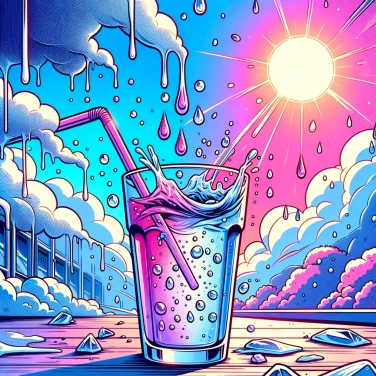When warm and humid air comes into contact with a cold object, the air cools down and can no longer hold as much water vapor. This leads to the condensation of moisture in the form of water droplets on the cold object.

The air that surrounds us always contains a bit of humidity, that is, water vapor in a completely invisible gas form. When this warm, humid air meets a colder surface, it loses the ability to hold all that humidity, and voilà, some of it returns to liquid form. This transition of water from a gaseous state to a liquid state is called condensation. Specifically, when the suspended water molecules cool down, their agitation decreases. They slow down, come closer together, and eventually assemble again into water droplets. The practical result: you see small droplets clearly visible on the cold glass or the bottle just taken out of the fridge.
The air around us always contains a certain amount of water vapor, invisible to the naked eye. When this warm, humid air meets a colder surface, the temperature of the air decreases upon contact with that surface. This drop reduces the air's capacity to hold water in a gaseous state: it reaches what is called the dew point. At this stage, the water vapor can no longer remain invisible and returns to a liquid state. That’s why you see droplets of water appearing on your cold drink or on your mirror after your hot shower. The greater the temperature difference between the humid air and the surface, the more pronounced the condensation will be.
When humidity begins to condense on a cold surface, it doesn't immediately form large visible droplets. At first, these are just tiny microdroplets scattered everywhere. As it cools further, these small droplets stick together: this is coalescence. The more they merge, the larger these droplets become. Eventually, they become heavy enough to move, gradually sliding down the surface. This is when larger water droplets clearly appear. This is exactly what you observe when you take a cold drink out of the fridge: at first, barely damp, and then very quickly covered in pretty droplets ready to stream down.
Each type of surface has its own effect on the formation of water droplets. For example, a super smooth surface like glass or a car body often promotes the formation of well-defined droplets because water adheres less easily to it, forming distinct droplets. In contrast, a rougher or porous material, such as raw wood or fabric, can partially absorb moisture, thereby limiting the clear formation of visible droplets. Temperature and material also significantly affect the speed and size of the droplets: in humid weather or when the surrounding air is saturated with water vapor, this is even more noticeable on cold metallic objects (a chilled soda can, metal railings in the morning). Finally, some special coatings, known as water-repellent, greatly reduce the adhesion of droplets, causing them to slide off quickly and not remain for long.
You often notice fine droplets on the can of soda that you just took out of the fridge: the warm, humid air around cools when it touches the cold metal, and voilà, droplets appear. The same goes for the mirror in your bathroom after your hot shower; the humidity in the air meets the cold glass and fogs up your mirror. When you take something out of the freezer, like a bag of frozen vegetables, after a few minutes outside, the surface becomes damp due to condensation. It’s exactly the same on windows in winter: the cold outside cools the inner surface of the window, and the warm air inside condenses, sometimes even forming drips. These little everyday moments are exactly condensation in action.
Some insects living in deserts, such as the Namib beetle, use condensation on their bodies to capture and collect the water necessary for their survival in a very arid environment!
The small droplets of water that appear on the outside of a cold beverage come from the ambient humidity condensing on the cold container, and not from a leak from inside the drink!
Engineers have developed surfaces capable of precisely controlling condensation to easily harvest drinking water from ambient humidity, a promising technology in desert regions.
The morning dew you see on plants or grass comes from condensation; during the night, the temperature drops, reaching a point where the water vapor in the air spontaneously forms droplets that are precious for the ecosystem.
The cold from the bottle cools the surrounding humid air upon contact, rapidly lowering its temperature below the dew point, resulting in the immediate formation of tiny water droplets on its outer surface.
You can reduce condensation on your mirrors by increasing the ventilation in your bathroom, for example by opening a window or using a humidity extractor fan. Slightly warming the mirror with built-in heating elements is another effective solution.
Sure! Here’s the translation: "Yes, excessive and regular condensation can cause various problems such as the development of mold, the degradation of paints or coatings, and even damage to water-sensitive materials like wood or textiles. It is essential to ensure proper ventilation in humid spaces to avoid these issues."
In winter, the cooled windows come into contact with the warm, humid air present inside the homes. When this warm air touches the cold surface of the windows, its temperature drops below the dew point, resulting in condensation in the form of visible water droplets.
Condensation is the process of water transitioning from a gaseous state to a liquid state, while evaporation is the reverse phenomenon: the transition of water from a liquid to a gaseous state. Condensation occurs when humid air comes into contact with a cold surface, whereas evaporation takes place through heating or when the surrounding air can absorb more moisture.

No one has answered this quiz yet, be the first!' :-)
Question 1/6